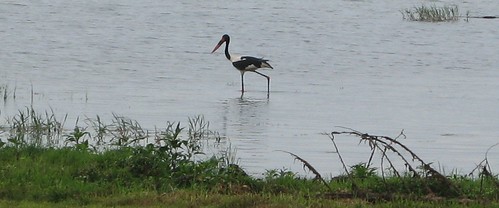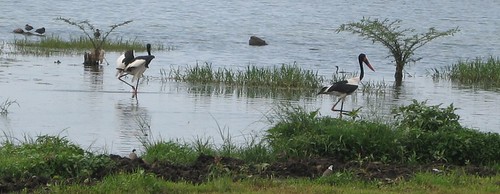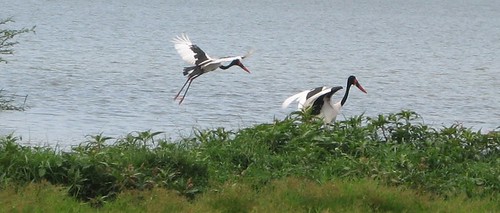Tuesday, October 21, 2008
More BOPs
But the feature attraction, for me, was the varied collection of birds of prey that came through. There had been some thunderstorms in the area, and there were also flights of breeding termites ascending, so conditions were especially conducive for any migrants in the neighborhood to steer a course through our neck of the woods.
* A number of common (steppe) buzzards (Buteo buteo)
* Several shikras (little banded goshawk -- Accipiter badius) -- not migrants, but out chasing the winged termites
* Several falcons, including a few European hobbies (F. subbuteo) and some possible lesser kestrels (F. naumanni)
* Two light-colored harriers that looked more like male Montagu's harriers (Circus pygargus) than anything else; they were certainly either Montagu's or pallid harriers (Circus macrourus)
We also had plenty of African black kites (Milvus migrans) around, as well as lizard buzzards (Kaupifalco monogrammicus) and a hooded vulture (Necrosyrtes monachus) or two.
Wednesday, October 15, 2008
B.O.P.s
A few days back a large falcon passed by, too quickly for positive ID, but odds are that it was a lanner (F. biarmicus).
Yesterday we had a couple of migrating common (steppe) buzzards (Buteo buteo) overhead.
And this morning while we were at breakfast, the distinctive display call of the male African goshawk came in through the window from obviously close quarters. We dashed over to have a look, and sure enough, there he was, perched in bright sunlight only 20 meters or so from us on a branch of one of our musizi trees (Maesops emini). I grabbed binoculars and had an excellent look at him before he departed his post under pressure from some pied crows (Corvus albus) that were harrassing him.
Monday, October 6, 2008
Morning bishops and sunbirds
Sunbirds I came across included olive-bellied (Nectarinia chloropygia), scarlet-chested (Nectarinia senegalensis), bronze (Nectarinia kilimensis), marico (Nectarinia mariquensis) and little purple-banded (Nectarinia bifasciata). Had particularly fine views of male bronze and marico sunbirds working their way up Leonotis stems as they breakfasted on nectar from the tubular orange flowers. Marico and little purple-banded can be difficult to distinguish from each other, and I have seldom if ever before seen both species on one outing.
Our principal bishop species here in town is the black bishop (Euplectes gierowii), and during breeding season it's not unusual to come across a male decked out in regal red, yellow and black, displaying in an area with long grass and shrubs. This morning I was surprised to see at least four and possibly six different males in full nuptial splendor, all in a fairly small area. I also noticed at female or two and some juveniles, evidence of some reproductive success this season.
Other highlights:
* Wire-tailed swallow (Hirundo smithii) collecting mud from a puddle margin for nest-building
* African green pigeon (Treron calva), a pair in a musasa (Sapium ellipticum) tree, one of them on a nest
* In the canary category, both African citril (Serinus citrinelloides) and yellow-fronted canary (Serinus mozambicus)
* Shrikes: brown-crowned tchagra (Tchagra australis) -- am used to encountering them outside of town, but this was the first instance for me in our neighborhood) -- and northern puffback (Dryoscopus gambensis)
* Red-faced cisticola (Cisticola erythrops)
* African blue flycatcher (Elminia longicauda)
* The African black kites (Milvus migrans) are back in force after their seasonal absence, and I also saw some of the first bronze-tailed starlings (Lamprotornis chalcurus) back in this area from their annual intra-Africa migration. If the bronze-tails return to roosting in the Markhamia and adjoining trees on the north side of our house as they did last year, our evenings and early mornings are about to become noticeably noisier!
Monday, September 15, 2008
Wetland outings
* Grey crowned crane
* Weavers: Northern brown-throated, Vieillot's black, Slender-billed, Yellow-backed, Black-headed
In other news, European and Blue-cheeked bee-eaters are regular overhead these days in their southward migration. And we're beginning to have a few African black kites in the neighborhood again, and the small group of Bronze-tailed starlings that we saw while birding in the swamp today are the first I've seen in the area in a while.
Saturday, September 6, 2008
Saddle-bill storks, Entebbe






Friday, September 5, 2008
Overheard
In other news...I came across the spectacular Levaillant's cuckoo (Oxylophus levaillantii) while walking in another part of our neighborhood the other day. We continue to hear, and occasionally see, western black-headed orioles. Still only the occasional African black kite (Milvus migrans) and no bronze-tailed starlings (Lamprotornis chalcurus) for a while; these are two of our intra-Africa or regional migrants and I'm still trying to work out exactly what are the normal limits of their seasonal presence with us.
Jonathan and I did a little birding last Monday morning in a narrow band of mixed-acacia woodland at the edge of a wetland just west of Mbale town. We had the pleasure of seeing, among others, African spoonbill (Platalea alba), white-faced whistling duck (Dendrocygna viduata) quite a number of red-headed lovebirds (Agapornis pullarius), white-throated and little bee-eaters (Merops albicollis and pusillus), marsh tchagra (Tchagra minuta), fan-tailed widowbird (Euplectes axillaris), and pin-tailed whydah (Vidua macroura).
Monday, September 1, 2008
Mburo, Mbarara, Entebbe highlights
* Saddle-billed stork (Ephippiorhynchus senegalensis) -- a pair in the shallows of Lake Victoria at Entebbe; eventually they were put to flight by someone's retriever that had great fun splashing after them for a hundred meters or so
* Glossy ibis (Plegadis falcinellus) -- Entebbe
